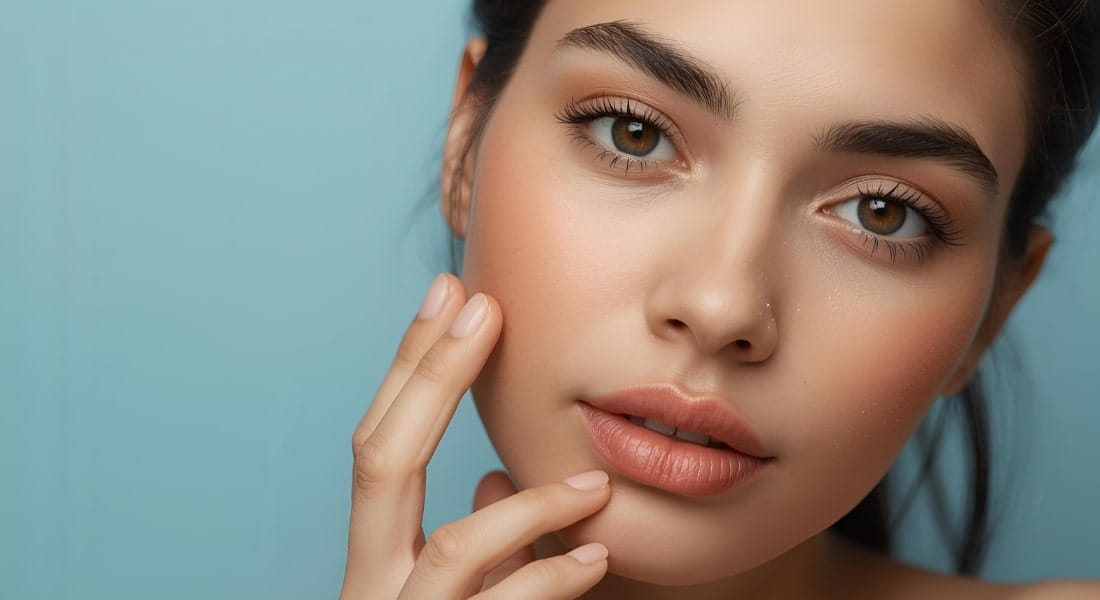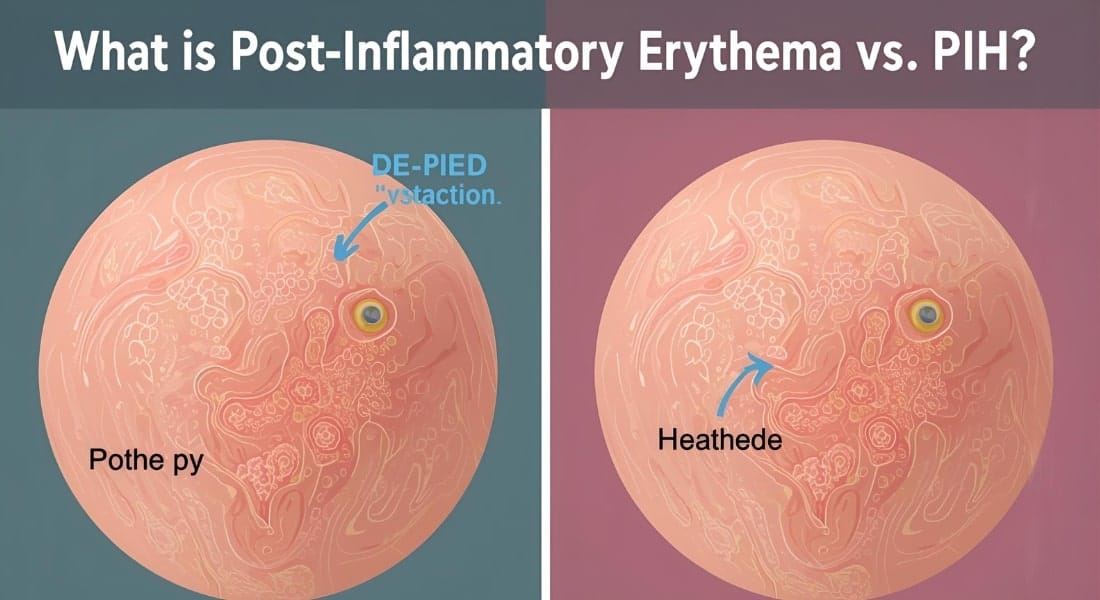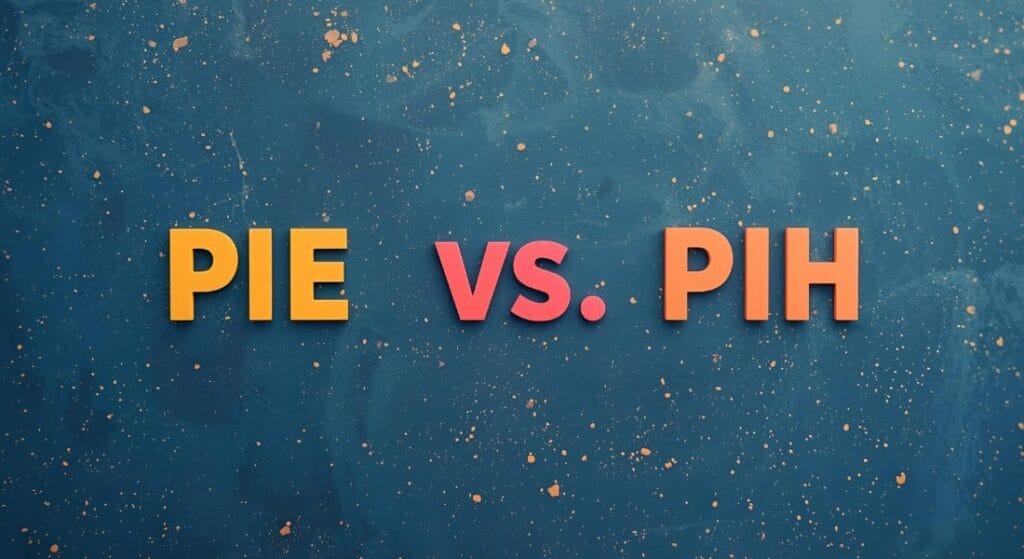The battle with acne doesn’t always end when the pimple disappears. Often, what’s left behind can be just as frustrating: stubborn red or brown marks that seem to linger forever. This “acne aftermath” is a source of great confusion, with many people mistaking these marks for true scars. The key to successfully treating these spots lies in understanding what they truly are. Are they red marks, or are they brown spots? This seemingly simple difference is the key to unlocking the right treatment.
In the world of dermatology, these marks are known as Post-Inflammatory Erythema (PIE) and Post-Inflammatory Hyperpigmentation (PIH). While both are a direct result of skin inflammation from a breakout, their underlying causes and, most importantly, their treatment approaches are completely different. This article will serve as a definitive guide to understanding the difference between PIE and PIH, helping you identify your specific skin concern and find a targeted, effective solution.
What is Post-Inflammatory Erythema (PIE)?
Post-Inflammatory Erythema, or PIE, refers to the persistent flat, red or pink marks that remain on the skin after a pimple has healed. The word “erythema” itself means redness.
Causes and Appearance
PIE is not caused by a change in skin pigment. Instead, it is a vascular issue. During a breakout, the skin experiences significant inflammation. In response, blood vessels in the affected area swell and become dilated to help the body fight off the infection and repair the damaged tissue. Even after the inflammation subsides, these tiny capillaries can remain damaged and dilated, leading to a lingering red or pink appearance. This is why PIE can look especially bright red when you’re flushed, hot, or have just exercised.
A simple test can help you identify PIE. If you gently press a clear drinking glass against the red mark, the redness will temporarily disappear and then return when you release the pressure. This is called a “blanching” effect and confirms that the redness is caused by blood vessel dilation.
Who is More Prone to PIE?
While anyone can get PIE, it is more commonly seen in individuals with lighter skin tones (Fitzpatrick skin types I-III). The lack of underlying melanin to mask the dilated blood vessels makes the redness more visible on lighter complexions.
What is Post-Inflammatory Hyperpigmentation (PIH)?
In contrast to PIE, Post-Inflammatory Hyperpigmentation (PIH) is a discoloration, or dark spot, that is left behind after a breakout.

Causes and Appearance
PIH is a pigment-related issue. When a pimple causes inflammation, the skin’s natural healing response can go into overdrive, leading to an overproduction of melanin, the pigment that gives skin its color. This excess melanin is then deposited in the upper layers of the skin, resulting in a flat, dark spot that can range in color from light brown to black.
Unlike PIE, PIH does not “blanch” when you press on it with a glass, as the color comes from melanin deposits, not blood vessels. These marks are typically brown or black and their color remains constant regardless of blood flow.
Who is More Prone to PIH?
PIH is more common in individuals with medium to darker skin tones (Fitzpatrick skin types III-VI). These skin types have a higher natural melanin content, making them more susceptible to an overproduction of pigment in response to inflammation or trauma.
Key Differences Between PIE and PIH
Misdiagnosing your skin marks can lead to months of ineffective treatment. For example, using a pigment-fading serum on a red PIE mark will have little to no effect. Conversely, relying on a vascular laser for a brown PIH spot won’t work. Understanding the difference between PIE and PIH is the most critical step toward effective healing.
PIE vs. PIH: At a Glance
Post-Inflammatory Erythema (PIE):
- Color: Red, Pink
- Cause: Damaged/Dilated blood vessels
- Test: Blanching (temporarily disappears when pressed)
- Skin Type: More common in lighter skin tones
- Treatment: Focus on anti-inflammatory ingredients, vascular lasers
Post-Inflammatory Hyperpigmentation (PIH):
- Color: Brown, Dark Brown, Black
- Cause: Overproduction of melanin pigment
- Test: Non-blanching (color remains when pressed)
- Skin Type: More common in medium to darker skin tones
- Treatment: Focus on brightening agents, chemical peels
Side-by-Side Comparison Table
| Feature | Post-Inflammatory Erythema (PIE) | Post-Inflammatory Hyperpigmentation (PIH) |
| Primary Cause | Vasodilation (blood vessel dilation) from inflammation. | Overproduction of melanin pigment from inflammation. |
| Appearance/Color | Flat, reddish or pinkish marks. | Flat, brownish or dark spots. |
| Skin Tones Most Affected | Lighter skin tones (Fitzpatrick I-III) | Medium to darker skin tones (Fitzpatrick III-VI) |
| Clinical Test | Blanches when a glass is pressed on it. | Does not blanch when a glass is pressed on it. |
| Primary Treatment Focus | Anti-inflammatory and vascular-targeting therapies. | Pigment-inhibiting and cell turnover-promoting ingredients. |
Treatment Approaches for PIE and PIH
Since the causes are so different, the treatments must also be distinct. A combined approach is often needed, especially since some people experience both marks.

How to Treat Post-Inflammatory Erythema (PIE)
The primary goal for treating PIE is to calm inflammation and address the underlying blood vessel issue.
- Anti-Inflammatory Ingredients: Skincare that soothes the skin and reduces redness is key. Look for ingredients like Niacinamide, Centella Asiatica (Cica), Azelaic Acid, and Green Tea Extract. These help to calm the skin and reduce the inflammatory response that causes vessel dilation.
- Laser and Light-Based Therapies: For more persistent PIE, in-office treatments are often the most effective. Vascular lasers, such as the Pulsed Dye Laser (PDL) or Intense Pulsed Light (IPL), specifically target the hemoglobin in the blood vessels, causing them to collapse and be reabsorbed by the body, effectively reducing the redness.
How to Treat Post-Inflammatory Hyperpigmentation (PIH)
For PIH, the focus is on breaking down and shedding the excess melanin and preventing future overproduction.
- Topical Brightening Agents: Ingredients that inhibit melanin production or speed up cell turnover are essential.
- Vitamin C: A powerful antioxidant that brightens skin and inhibits the enzyme responsible for melanin synthesis.
- Retinoids: Accelerate cell turnover, helping to shed pigmented skin cells faster and reveal fresh skin underneath.
- Niacinamide: Helps to block the transfer of melanin to skin cells, preventing new spots from forming.
- Azelaic Acid: A multitasking ingredient that helps with both inflammation and pigment.
- Chemical Peels: In-office peels with ingredients like glycolic acid or salicylic acid can exfoliate the top layers of the skin, helping to fade dark spots and even out skin tone.
An Advanced Solution for Both: SWYADA EXOCICAR
It’s important to remember that a healthy skin barrier is crucial for healing, regardless of whether you have PIE or PIH. An inflamed, compromised barrier makes your skin more vulnerable to both vascular and pigmentary damage. This is where advanced solutions come in. Advanced formulations like SWYADA EXOCICAR help repair the skin barrier and improve outcomes for both PIE and PIH. Its unique formulation is designed to calm inflammation, strengthen the skin’s natural resilience, and support the overall repair process. By tackling the root cause of the marks—the inflammatory response—it serves as a powerful support system for your targeted treatments.
At-Home Care Tips
Your daily habits play a huge role in the fading of acne marks.
- Sun Protection is Non-Negotiable: Sun exposure is the number one enemy for both PIE and PIH. UV rays can darken PIH, making it much harder to fade, and cause further inflammation that can worsen PIE. Use a broad-spectrum sunscreen with at least SPF 30 every single day.
- Gentle is Best: Avoid harsh scrubs, over-exfoliation, or stripping cleansers. These can damage your skin barrier, increase inflammation, and slow down the healing process.
- Patience and Consistency: There is no overnight fix for these marks. It can take months of consistent, targeted care to see a significant improvement. Stick with your routine and be patient.
Frequently Asked Questions
Q: What is the difference between PIE and PIH?
A: PIE (Post-Inflammatory Erythema) is a red mark caused by damaged blood vessels after a breakout, common in lighter skin tones. PIH (Post-Inflammatory Hyperpigmentation) is a brown mark caused by excess melanin, common in darker skin tones.
Q: How do you treat PIE at home?
A: At-home treatment for PIE focuses on reducing inflammation and protecting the skin. Use products with calming ingredients like niacinamide, Centella Asiatica, or azelaic acid. Daily use of a broad-spectrum SPF is also crucial to prevent the redness from worsening.
Q: How long does PIE take to fade?
A: The fading time for PIE varies, but it can take anywhere from a few months to over a year. With a proper skincare routine focused on anti-inflammatory ingredients and sun protection, you can help speed up the process.
Q: What products help with PIH?
A: Products for PIH should focus on inhibiting melanin and promoting cell turnover. Look for ingredients like Vitamin C, retinoids, niacinamide, and azelaic acid. Chemical exfoliants can also help to shed the pigmented skin cells.
Q: Can PIE turn into PIH?
A: It is possible. The inflammation that causes PIE can also trigger the overproduction of melanin, especially in skin types prone to PIH. Therefore, reducing inflammation early on is key to preventing PIE from potentially developing into PIH.

Conclusion
Understanding the subtle yet critical difference between PIE and PIH is the first step toward clearer skin. While PIE is a vascular issue causing red marks, PIH is a pigmentary issue leading to brown spots. Correct identification allows for a targeted treatment plan—using anti-inflammatory and vascular treatments for PIE and pigment-inhibiting ingredients for PIH.
By combining this knowledge with smart daily habits, such as rigorous sun protection, and supporting your skin’s health with advanced barrier-repair solutions like SWYADA EXOCICAR, you can effectively address these stubborn marks and restore a smooth, even complexion. Remember, the journey to clear skin is not about quick fixes but about consistent, informed care.

